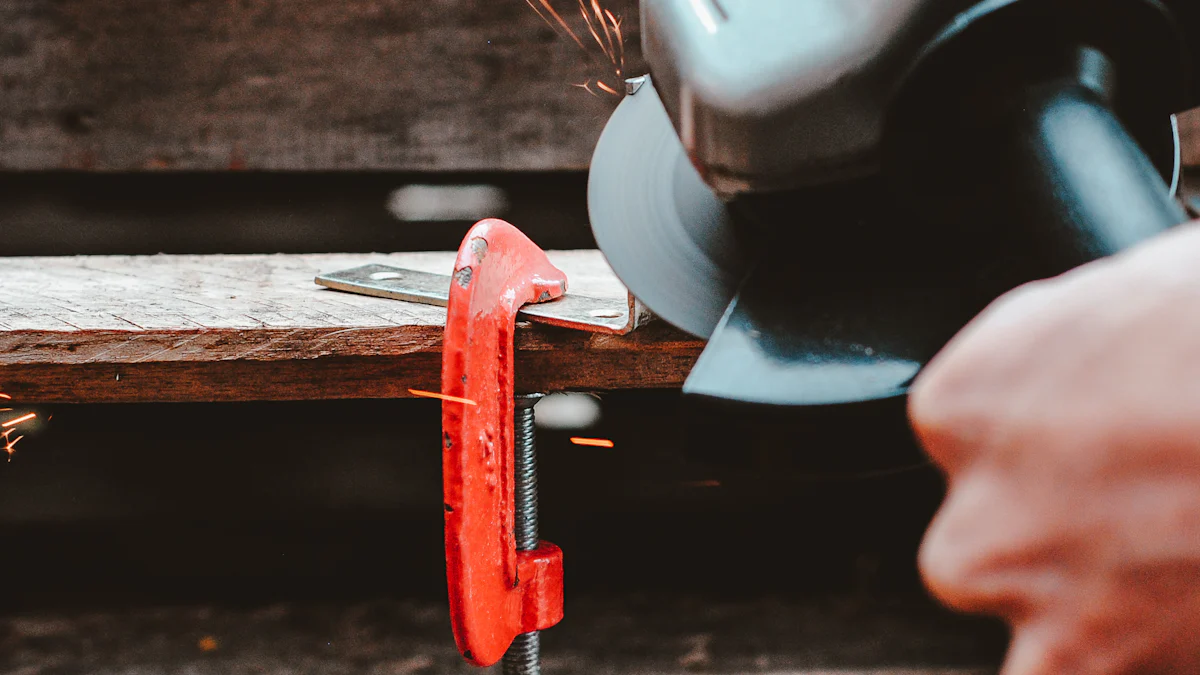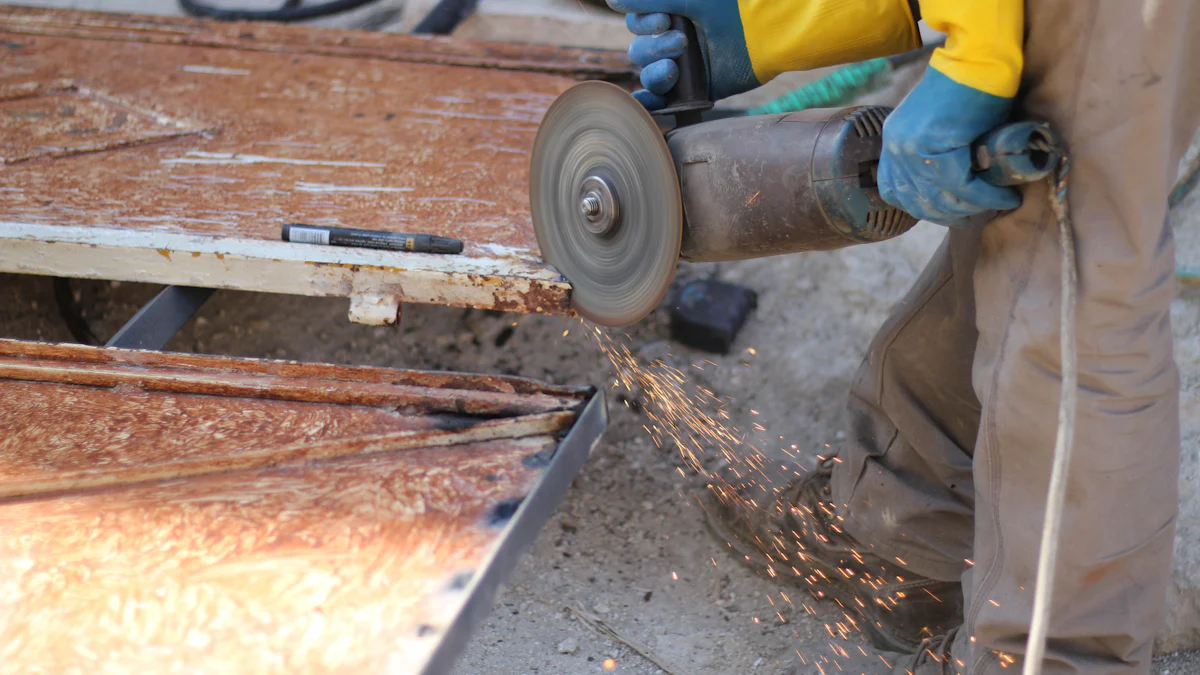
Choosing the right tool for cutting metal sheets makes a big difference in your work. The right cut metal sheet tool gives you clean and precise cuts. You save time and effort with the right choice. Different tools suit different tasks. Some tools handle thick metals, while others excel with thin sheets. Consider factors like material type, task complexity, and budget. Carbide-based tools offer great hardness and speed for demanding jobs. The right tool enhances efficiency and accuracy, making your projects smoother and more enjoyable.
Types of Metal Cutting Tools

Choosing the right cut metal sheet tool can make your projects much easier and more efficient. Let’s dive into the different types of tools you might consider for your metal cutting needs.
Manual Tools
Tin Snips
Tin snips work great for cutting thin metal sheets. These tools resemble scissors and offer precise control. You can find straight snips for long, straight cuts. Left-cutting and right-cutting snips help with curves and circles. Compound snips provide extra power for thicker metals. Beginners often start with tin snips due to their simplicity.
Hacksaws
Hacksaws serve as versatile tools in metalworking. These handheld tools come with fine-toothed blades. Hacksaws offer precision and control. You can use them for straight cuts in smaller metal pieces. A hacksaw proves useful when you need a quick solution without power tools.
Power Tools
Angle Grinders
Angle grinders deliver speed and efficiency. These tools can cut through various metals, including sheets, tubes, or bars. Angle grinders use abrasive discs to slice through metal. You can achieve fast results with minimal effort. Always prioritize safety when using angle grinders.
Circular Saws
Circular saws excel at cutting large metal sheets. With the right blade, these saws can handle metal efficiently. Blades with carbide teeth or abrasive discs work best. Circular saws offer different blade sizes and tooth configurations. You can choose one based on your specific needs.
Specialized Tools
Plasma Cutters
Plasma cutters provide precision and speed. These tools use a high-velocity jet of ionized gas to cut metal. Plasma cutters work well on thick materials. You can achieve clean and accurate cuts with minimal effort. These tools suit both industrial and hobbyist applications.
Laser Cutters
Laser cutters offer unmatched precision. These tools use focused laser beams to cut through metal. Laser cutters excel at intricate designs and detailed work. You can achieve smooth edges and complex shapes easily. These tools often find use in manufacturing and custom metalwork.
Key Considerations for Tool Selection
Choosing the right cut metal sheet tool involves more than just picking one off the shelf. You need to think about precision, safety, and technique. Let’s break down these key considerations to help you make the best choice.
Precision
Importance of Precision in Metal Cutting
Precision plays a huge role in metal cutting. Accurate cuts ensure that your projects fit together perfectly. Precision reduces waste and saves materials. A precise cut metal sheet tool helps achieve clean edges and detailed designs. For example, using guides and jigs can help you get precise angles and shapes. Mastering plunge cutting lets you create intricate designs with ease.
Tools That Offer High Precision
Certain tools excel in providing high precision. Laser cutters stand out for their unmatched accuracy. These tools use focused beams to cut through metal like butter. Plasma cutters also offer excellent precision, especially for thicker materials. CNC machines take precision to another level with automated and highly accurate cutting. These machines let you program complex patterns and watch them come to life.
Safety
Safety Measures for Manual Tools
Safety should always be a top priority when using any cut metal sheet tool. Manual tools like tin snips and hacksaws require proper handling. Always wear gloves to protect your hands from sharp edges. Keep your workspace clean to avoid accidents. Make sure your tools are in good condition before starting any project.
Safety Measures for Power Tools
Power tools demand even more attention to safety. Angle grinders and circular saws can be dangerous if not used correctly. Always wear safety goggles to protect your eyes from flying debris. Use ear protection to guard against loud noises. Secure your metal sheets firmly before cutting to prevent slipping. Follow the manufacturer’s instructions for each tool to ensure safe operation.
Technique
Proper Handling of Tools
Proper handling of your cut metal sheet tool makes a big difference in the outcome. Hold your tools firmly but comfortably. Maintain a steady hand to guide your cuts accurately. Practice your grip and stance to improve control. With manual tools, use smooth and even strokes for the best results.
Techniques for Efficient Cutting
Efficiency in cutting comes from mastering the right techniques. For straight cuts, use a ruler or guide to keep your lines true. When working with curves, move slowly and steadily. Experiment with different tools to find what works best for your project. Consider using modern multitasking machines for complex tasks. These machines expand your cutting strategies and capabilities.
Choosing the right cut metal sheet tool involves understanding these key considerations. By focusing on precision, safety, and technique, you can enhance your metalworking skills and achieve outstanding results.
Summary of Tool Selection
Choosing the right cut metal sheet tool can make a world of difference in your projects. Let’s recap the key points to ensure you make the best choice.
Recap of Key Points
First, consider the type of metal you’re working with. Different metals require different tools. Tin snips work well for thin sheets. Angle grinders handle thicker materials efficiently. Plasma cutters offer precision for complex designs. Always match the tool to the task for optimal results.
Next, think about the level of precision you need. Laser cutters provide unmatched accuracy. Hacksaws offer control for smaller pieces. Precision ensures clean cuts and reduces waste. Choose a tool that meets your precision needs.
Finally, don’t forget about safety. Protecting yourself is crucial when using any cut metal sheet tool. Safety glasses shield your eyes from flying debris. Gloves protect your hands from sharp edges. Ear protection guards against loud noises. Always prioritize safety measures to prevent accidents.
Emphasis on Safety and Technique
Safety should always be your top priority. Metal cutting involves risks. Wearing safety gear minimizes those risks. A clean workspace prevents accidents. Regularly check your tools for wear and tear. Safe practices keep you protected.
Proper technique enhances efficiency. Hold your cut metal sheet tool firmly. Maintain a steady hand for accurate cuts. Practice improves your skill and confidence. Experiment with different tools to find what works best for you. Mastering techniques leads to better results.
Learning how to cut metal safely and accurately is invaluable. The right cut metal sheet tool makes your work easier and more enjoyable. Focus on safety and technique to achieve outstanding results. Happy cutting!
Using the right cut metal sheet tool makes your work smoother and more efficient. Each tool suits specific tasks, so choose wisely. Safety remains crucial in every project. Protect yourself with gloves and goggles. Keep your workspace tidy to avoid accidents. Efficiency improves with practice. Try different techniques and tools to find what works best. Young, a seasoned metalworker, once said, “When jobs come up, and I’m in a rush for it, they’ve got it.” This highlights the importance of having the right tool ready. Keep practicing to refine your skills and achieve precision.
